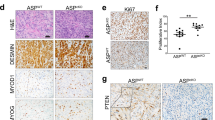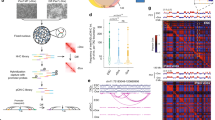Abstract
Alveolar rhabdomyosarcoma (aRMS), an aggressive skeletal muscle cancer, carries a unique t(2;13) chromosomal translocation resulting in the formation of a chimeric transcription factor PAX3-FKHR. This fusion protein contains the intact DNA-binding domains (PD: paired box binding domain; HD: paired-type homeodomain) of Pax3 fused to the activation domain of FKHR. Cells expressing Pax3 and PAX3-FKHR show vastly different gene expression patterns, despite that they share the same DNA-binding domains. We present evidence of a gain of function mechanism that allows the fusion protein to recognize and transcriptionally activate response elements containing a PD-specific binding site. This DNA recognition specificity is in contrast to the requirement for Pax3-specific target sequences that must contain a composite of PD-and HD-binding sites. Domain swapping studies suggest that an increased structural flexibility could account for the relaxed DNA targeting specificity in PAX3-FKHR. Here, we identify myogenin gene as a direct target of PD-dependent PAX3-FKHR activation pathway in vitro and in vivo. We demonstrate that PAX3-FKHR could induce myogenin expression in undifferentiated myoblasts by a MyoD independent pathway, and that PAX3-FKHR is directly involved in myogenin expression in aRMS cells.
This is a preview of subscription content, access via your institution
Access options
Subscribe to this journal
Receive 50 print issues and online access
$259.00 per year
only $5.18 per issue
Buy this article
- Purchase on Springer Link
- Instant access to full article PDF
Prices may be subject to local taxes which are calculated during checkout










Similar content being viewed by others
References
Anderson J, Ramsay A, Gould S, Pritchard-Jones K . (2001). Embryonic expression of the tumor-associated PAX3-FKHR fusion protein interferes with the developmental functions of Pax3. Am J Path 159: 1089–1096.
Barr FG . (1997). Fusions involving paired box and fork head family transcription factors in the pediatric cancer alveolar rhabdomyosarcoma. Curr Topics Micro Immun 220: 113–129.
Barr FG, Galili N, Holick J, Biegel JA, Rovera G, Emanuel BS . (1993). Rearrangement of the PAX3 paired box gene in the paediatric solid tumour alveolar rhabdomyosarcoma. Nat Genet 3: 113–117.
Begum S, Emani N, Cheung A, Wilkins O, Der S, Hamel PA . (2005). Cell-type-specific regulation of distinct sets of gene targets by Pax3 and Pax3/FKHR. Oncogene 24: 1860–1872.
Bernasconi M, Remppis A, Fredericks WJ, Rauscher III FJ, Schafer BW . (1996). Induction of apoptosis in rhabdomyosarcoma cells through down-regulation of PAX proteins. Proc Natl Acad Sci USA 93: 13164–13169.
Buchberger A, Ragge K, Arnold HH . (1994). The myogenin gene is activated during myocyte differentiation by pre-existing, not newly synthesized transcription factor MEF-2. J Biol Chem 269: 17289–17296.
Cao Y, Wang C . (2000). The COOH-terminal transactivation domain plays a key role in regulating the in vitro and in vivo function of Pax3 homeodomain. J Biol Chem 275: 9854–9862.
Chalepakis G, Goulding M, Read A, Strachan R, Gruss P . (1994a). Moleulcar basis of splotch and Waardenburg Pax-3 mutations. Proc Natl Acad Sci USA 91: 3685–3689.
Chalepakis G, Jones FS, Eelman GM, Gruss P . (1994b). Pax-3 contains domains for transcription activation and transcription inhibition. Proc Natl Acad Sci USA 91: 12745–12749.
Chalepakis G, Gruss P . (1995). Identification of DNA recognition sequences for the Pax3 paired domain. Gene 162: 267–270.
Cheng TC, Hanley TA, Mudd J, Merlie JP, Olson EN . (1992). Mapping of myogenin transcription during embryogenesis using transgenes linked to the myogenin control region. J Cell Biol 119: 1649–1656.
Cheng TC, Wallace MC, Merlie JP, Olson E.N . (1993). Separable regulatory elements governing myogenin transcription in mouse embryogenesis. Science 261: 215–218.
De Pitta C, Tombolan L, Albiero G, Sartori F, Romualdi C, Jurman G et al. (2006). Gene expression profiling identifies potential relevant genes in alveolar rhabdomyosarcoma pathogenesis and discriminates PAX3-FKHR positive and negative tumors. Int J Cancer 118: 2772–2781.
Dias P, Chen B, Dilday B, Palmer H, Hosoi H, Singh S et al. (2000). Strong immunostaining for myogenin in rhabdomyosarcoma is significantly associated with tumors of the alveolar subclass. Am J Path 156: 399–408.
Douglass EC, Valentine M, Etcubanas E, Parham D, Webber BL, Houghton PJ et al. (1987). A specific abnormality in rhabdomyosarcoma. Cyto Cell Genet 45: 148–155.
Epstein JA, Lam P, Jepeal L, Maas RL, Shapiro DN . (1995). Pax3 inhibits myogenic differentiation of cultured myoblast cells. J Biol Chem 270: 11719–11722.
Epstein JA, Song B, Lakkis M, Wang C . (1998). Tumor-specific PAX3-FKHR transcription factor, but not PAX3, activates the platelet-derived growth factor alpha receptor. Mol Cell Biol 18: 4118–4130.
Folpe AL . (2002). MyoD1 and myogenin expression in human neoplasia: a review and update. Adv Anat Path 9: 198–203.
Fredericks WJ, Galili N, Mukhopadhyay S, Rovera G, Bennicelli J, Barr FG et al. (1995). The PAX3-FKHR fusion protein created by the t(2;13) translocation in alveolar rhabdomyosarcomas is a more potent transcriptional activator than PAX3. Mol Cell Biol 15: 1522–1535.
Goulding MD, Chalepakis G, Deutsch U, Erselius JR, Gruss P . (1991). Pax3, a novel murine DNA binding proein expressed duringearly neurogeneisis. EMBO J 10: 1135–1147.
Hostein I, Andraud-Fregeville M, Guillou L, Terrier-Lacombe MJ, Deminiere C, Ranchere D et al. (2004). Rhabdomyosarcoma: value of myogenin expression analysis and molecular testing in diagnosing the alveolar subtype: an analysis of 109 paraffin-embedded specimens. Cancer 101: 2817–2824.
Jen Y, Weintraub H, Benezra R . (1992). Overexpression of Id protein inhibits the muscle differentiation program: in vivo association of Id with E2A proteins. Genes Dev 6: 1466–1479.
Keller C, Arenkiel BR, Coffin CM, El-Bardeesy N, DePinho RA, Capecchi MR . (2004a). Alveolar rhabdomyosarcomas in conditional Pax3:Fkhr mice: cooperativity of Ink4a/ARF and Trp53 loss of function. Genes Dev 18: 2614–2626.
Keller C, Hansen MS, Coffin CM, Capecchi MR . (2004b). Pax3:Fkhr interferes with embryonic Pax3 and Pax7 function: implications for alveolar rhabdomyosarcoma cell of origin. Genes Dev 18: 2608–2613.
Khan J, Bittner ML, Sall LH, Teichmann U, Azorsa DO, Gooden GC et al. (1999). cDNA microarrays detect activation of a myogenic transcription program by the PAX3-FKHR fusion oncogene. Proc Natl Acad Sci USA 96: 13264–13269.
Lam PYP, Sublett JE, Hollenbach AD, Roussel MF . (1999). The oncogenic potential of the PAX3-FKHR fusion protein requires the Pax3 homeodomain recognition helix but not the Pax3 paired-Box DNA binding domain. Mol Cell Biol 19: 594–601.
Malik S, Huang CF, Schmidt J . (1995). The role of the CANNTG promoter element (E box) and the myocyte-enhancer-binding-factor-2 (MEF-2) site in the transcriptional regulation of the chick myogenin gene. Eur J Biochem 230: 88–96.
Michelagnoli MP, Burchill S.A, Cullinane C, Selby PJ, Lewis IJ . (2003). Myogenin--a more specific target for RT-PCR detection of rhabdomyosarcoma than MyoD1. Med Pediatr Oncol 40: 1–8.
Puri PL, Wu Z, Zhang P, Wood LD, Bhakta KS, Han J et al. (2000). Induction of terminal differentiation by constitutive activation of p38 MAP kinase in human rhabdomyosarcoma cells. Genes Dev 14: 574–584.
Scheidler S, Fredericks WJ, Rauscher JF, Barr GF, Vogt PK . (1996). The hybrid PAX3-FKHR fusion protein of alveolar rhabdomyosarcoma transforms fibroblasts in culture. Proc Natl Acad Sci USA 93: 9805–9809.
Shapiro DN, Sublett JE, Li B, Downing JR, Naeve CW . (1993). Fusion of PAX3 to a member of the Forkhead family of transcripton factors in human alveolar rhabdomyosarcoma. Cancer Res 53: 5108–5112.
Spicer DB, Rhee J, Cheung WL, Lassar AB . (1996). Inhibition of myogenic bHLH and MEF2 transcription factors by the bHLH protein Twist. Science 272: 1476–1480.
Spitz F, Demignon J, Porteu A, Kahn A, Concordet JP, Daegelen D et al. (1998). Expression of myogenin during embryogenesis is controlled by Six/sine oculis homeoproteins through a conserved MEF3 binding site. Proc Natl Acad Sci USA 95: 14220–14225.
Tapscott SJ, Thayer MJ, Weintraub H . (1993). Deficiency in rhabdomyosarcomas of a factor required for MyoD activity and myogenesis. Science 259: 1450–1453.
Turc-Carel C, Lizard-Nacol S, Justrabo E, Favrot M, Tabone E . (1986). Consistent chromosomal translocation in alveolar rhabdomyosarcoma. Cancer Genet Cyotgeneti 19: 361–362.
Wang-Wuu S, Soukup S, Ballard E, Gotwals B, Lampkin B . (1988). Chromosomal analysis of sixteen human rhabdomyosarcoma. Cancer Res 48: 983–987.
Weintraub M, Kalebic T, Helman JL, Bhatia GK . (1997). Disruption of the MyoD/p21 pathway in rhabdomyosarcoma. Sarcoma 1: 135–141.
Yee SP, Rigby PW . (1993). The regulation of myogenin gene expression during the embryonic development of the mouse. Genes Dev 7: 1277–1289.
Zhang L, Wang C . (2006). F-box protein Skp2: a novel transcriptional target of E2F. Oncogene 25: 2615–2627.
Acknowledgements
We thank Dr Reed Graves for the critical review of this manuscript. The work is supported by NIH grant (CA074907).
Author information
Authors and Affiliations
Corresponding author
Rights and permissions
About this article
Cite this article
Zhang, L., Wang, C. Identification of a new class of PAX3-FKHR target promoters: a role of the Pax3 paired box DNA binding domain. Oncogene 26, 1595–1605 (2007). https://doi.org/10.1038/sj.onc.1209958
Received:
Revised:
Accepted:
Published:
Issue Date:
DOI: https://doi.org/10.1038/sj.onc.1209958
Keywords
This article is cited by
-
A human Myogenin promoter modified to be highly active in alveolar rhabdomyosarcoma drives an effective suicide gene therapy
Cancer Gene Therapy (2021)
-
Reduced B7-H3 expression by PAX3-FOXO1 knockdown inhibits cellular motility and promotes myogenic differentiation in alveolar rhabdomyosarcoma
Scientific Reports (2021)
-
JARID2 is a direct target of the PAX3-FOXO1 fusion protein and inhibits myogenic differentiation of rhabdomyosarcoma cells
Oncogene (2014)
-
Alveolar rhabdomyosarcoma-associated proteins PAX3/FOXO1A and PAX7/FOXO1A suppress the transcriptional activity of MyoD-target genes in muscle stem cells
Oncogene (2013)
-
Carnitine palmitoyltransferase 1A (CPT1A): a transcriptional target of PAX3-FKHR and mediates PAX3-FKHR–dependent motility in alveolar rhabdomyosarcoma cells
BMC Cancer (2012)



